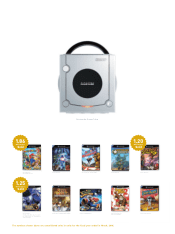Nintendo 2006 Annual Report Download - page 18
Download and view the complete annual report
Please find page 18 of the 2006 Nintendo annual report below. You can navigate through the pages in the report by either clicking on the pages listed below, or by using the keyword search tool below to find specific information within the annual report.
16
Nintendo Co., Ltd. and consolidated subsidiaries
The video game industry has developed as one of the few entertainment fields which was launched and driven by Japan.
Success of the industry in the early years was dependent upon increasingly spectacular graphics and more complex games. In
recent years, however, the traditional success formula of developing splendid and complex games has become less productive.
Nintendo’s strategy over the past year has been to expand the gaming population by introducing “Nintendo DS”, a handheld
gaming device equipped with a touch screen and microphone port that enables intuitive game play, along with wireless
communication capability. These features have made it possible to introduce software innovations that expand the definition of
video games. New user demographics, including seniors and females, have been cultivated by introducing a software lineup
known as “Touch! Generations”. “Touch! Generations” titles offer an entertaining experience that provide a fresh sensation to
skilled gamers while at the same time, making the experience easily accessible to those who were not familiar with video games
in the past. Nintendo will continue to develop the “Touch! Generations” initiative (which created a new flow in the world of
video games) while at the same time expanding its software lineup into various new fields.
“Nintendo Wi-Fi Connection”, a wireless internet service for the “Nintendo DS”, was recently introduced and has three key
elements; “easy, safe, and charge-free”. “Nintendo Wi-Fi Connection” quickly gained popularity and has been accepted by a
broad range of people.
In addition to the original “Nintendo DS”, Nintendo expects to further increase “Nintendo DS” hardware sales with the
addition of “Nintendo DS Lite”. “Nintendo DS Lite” launched in March 2006 in Japan and is a lighter and brighter version of
the “Nintendo DS” to meet various consumer preferences.
During the calendar year 2006, a new gaming console “Wii” (pronounced “We”) is scheduled for launch. With its
unprecedented controller, “Wii” aims to set a new standard as a video game interface which allows the whole family to enjoy it.
Overview
In the handheld game business, “Nintendo DS” and its new model “Nintendo DS Lite” sold a total of more than 16 million
units on a worldwide basis in just over sixteen months since launch. “Nintendo DS” is selling at a faster rate than any other
gaming device, especially in Japan. “Nintendo DS” software has also enjoyed a boost in sales as the “Touch! Generations”
titles, aimed at expanding the user base, have sold exceptionally well. Among these titles, “Nintendogs”, which allows the
player to interact with virtual puppies on the screen, sold 6.65 million units worldwide. Also from the lineup, a new brain
training genre, “Brain Age: Train Your Brain in Minutes a Day”, coupled with its sequel version, “Big Brain Academy”, released
only in Japan, brought total unit sales of these three “Touch! Generations” titles during the period to 5.10 million. In addition,
“Nintendo Wi-Fi Connection” compatible titles such as “Mario Kart DS”, (an action racing game that lets the player compete
against other players from around the world) sold 4.22 million units. Also, “Animal Crossing: Wild World”, (a game that lets
you communicate with friends) sold 3.56 million units.
In the console business, software titles for the “Nintendo GameCube” such as “Mario Party 7” (a get-together game that lets
up to eight players play simultaneously) and the role playing game “Pokémon XD: Gale of Darkness” each sold more than a
million units, however, overall console hardware and software sales declined.
As a result, consolidated net sales in Fiscal 2006 were ¥508.8 billion ($4,349 million). Gross margin was ¥215.0 billion
($1,838 million). The gross margin ratio stayed at 42% compared with the previous fiscal year. Selling, general and
administrative expenses amounted to ¥123.8 billion ($1,058 million). Operating income was ¥91.2 billion ($780 million). The
operating income ratio decreased by 4% compared with the previous fiscal year to 18%. Interest income was ¥22.5 billion
($192 million), while foreign exchange gain was ¥45.5 billion ($389 million) due to Japanese yen depreciation. As a result, net
income for Fiscal 2006 was ¥98.4 billion ($841 million). The net income ratio increased by 2% compared with the previous fiscal
year to 19%.
Revenue and Expenses
At March 31, 2006, Nintendo’s cash and cash equivalents were ¥617.1 billion ($5,275 million).
Net cash provided by operating activities was ¥46.4 billion ($396 million) despite reductions in cash due to a foreign exchange
gain resulting from revaluation of cash and cash equivalents in foreign currencies, payment of ¥74.9 billion ($640 million) for
income taxes and also due to a decrease in notes and trade accounts payable.
Net cash used in investing activities was ¥208.8 billion ($1,785 million) as payments into time deposits exceeded withdrawals.
Net cash used in financing activities was ¥60.2 billion ($514 million) due to dividend payments and payments for acquiring
treasury stocks.
Cash Flow
Analysis of Operations and Financial Review
























